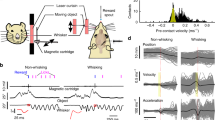Abstract
The dorsal vessel of the blood feeding insect,Rhodnius prolixus, was found to increase or decrease its rate of contraction in response to a number of different stimuli. Handling increased contraction rates whereas tactile stimulation of the ventral abdominal cuticle inhibited contraction. Injection of very low concentrations of serotonin or of high concentrations of octopamine enhanced the inhibitory effect, apparently by acting via the nervous system. Higher concentrations of serotonin increased heart rate by acting directly on the myocardium. The inhibitory response is suggested to be one facet of a generalised thigmotactic response.
Similar content being viewed by others
References
Hinks, C. F., Trans. Roy. ent. Soc.118 (1966) 375.
Miller, T., in: Comprehensive Insect Physiology, Biochemistry and Pharmacology, vol. 3. Eds G. A. Kerkut and L. I. Gilbert. Pergamon Press, New York 1985.
Wiggelsworth, V. B., Insect Physiology, 8th edn. Chapman and Hall, London 1984.
Davey, K. G., J. Insect Physiol.9 (1963) 375.
Davey, K. G., J. Insect Physiol.8 (1962) 259.
Davey, K. G., and Chiang, R. G., Arch. Insect Biochem. Physiol.11 (1989) 139.
Chiang, R. G., and Davey, K. G., Invert. Reprod. Develop.18 (1990) 177.
Chiang, R. G., Chiang, J. A., and Davey, K. G., J. Morphol.204 (1990) 9.
Platt, N., and Reynolds, S. E., J. Insect Physiol.32 (1986) 221.
Baehr, J.-C., and Baudry, N., C.r. Acad. Sci. Paris217 (1970) 115.
Gersch, M., Hentschel, E., and Ude, J., Zool. Jb. Physiol.78 (1974) 1.
Collins, C., and Miller, T., J. exp. Biol.67 (1977) 1.
Evans, P. D., Adv. Insect Physiol.15 (1980) 317.
Orchard, I., Can. J. Zool.60 (1982) 659.
Hokfelt, T., Lundberg, J., Skirboll, L., Johansson, O., Shultzberg, M., and Vincent, S. R., in: Co-transmission, p. 77. Ed. A. C. Cuello. MacMillan, London 1982.
Normann, T. C., Int. Rev. Cytol.46 (1976) 1.
Rosinski, G., and Gade, G., J. Insect Physiol.34 (1988) 1035.
Kuster, J. E., and Davey, K. G., Int. J. Invert. Reprod.6 (1983) 189.
Nassel, D. R., Prog. Neurobiol.30 (1988) 1.
Lange, A. B., Orchard, I., and Barrett, F. M., J. Insect Physiol.35 (1989) 393.
Author information
Authors and Affiliations
Rights and permissions
About this article
Cite this article
Chiang, R.G., Chiang, J.A. & Davey, K.G. A sensorory input inhibiting heart rate in an insect, Rhodnius prolixus. Experientia 48, 1122–1125 (1992). https://doi.org/10.1007/BF01948003
Received:
Accepted:
Published:
Issue Date:
DOI: https://doi.org/10.1007/BF01948003




